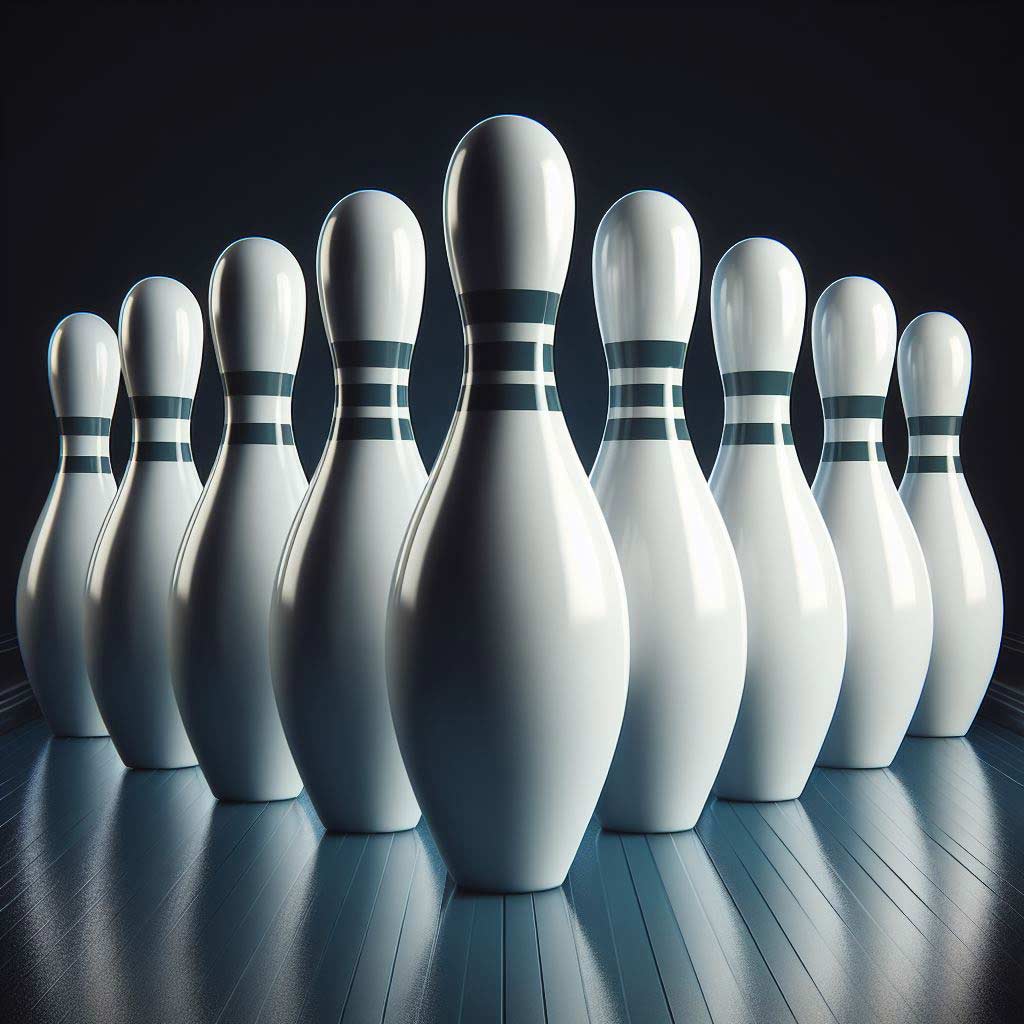Bowling alleys contain a very specific and iconic setup – 10 pins standing in a triangle formation at the end of each lane. But why 10 pins? Where did this standard configuration originate and has it always been the norm?
This article will provide a comprehensive breakdown answering the question of exactly how many pins are used in bowling lanes around the world and the reasoning behind the prevalent 10 pin format.
The Quick Answer: 10 Pins are Used in Modern Bowling
First, let’s directly answer the primary question that likely brought readers here – there are 10 pins set up at the end of every bowling lane for standard modern bowling.
This triangular formation with 4 pins on the back row, 3 pins in the middle, and 2 corner pins in front has been the international standard for over a century. Next, we’ll get into the details on pin specifications, placement, and maintenance.
Background of Bowling Pin History and Formats
Before diving into the specs of regulation 10-pin bowling equipment, it helps to understand the history. Variations of bowling date back over 5,000 years as an ancient pastime, though equipment and rules have evolved dramatically. The earliest forms used round stones and rocks as balls which were rolled toward targets that were commonly clubs or shaped wooden blocks.
The sport became more standardized and competitive in Europe during the Middle Ages. Germans developed key bowling innovations including shaped pin targets called kegels and the first ball with finger holes for grip in the 1400s. Nine wooden kegel pins arranged in a diamond became the standard during this era.
Bowling later peaked in popularity in post-Civil War America during the 1900s. Technological advancements lead to the first pinsetters which automated pin resetting plus the opening of large public alleys. This American style of 10-pin bowling began gaining traction.
Other major bowling formats still played today include:
- Nine-pin tap: A European format still popular today using 9 pins in a diamond. Extra points are scored if the ball knocks over pins after already clearing the deck.
- Five-pin bowling: Popular Canadian format using 5 pins in a V-shape without the back row. Smaller balls (under 3.5 lbs) are used for the shorter lanes.
- Candlepin Bowling: Played extensively in New England using thin stick-shaped pins that resemble candles. No sweep bar is used so fallen pins must be cleared manually between frames.
While each bowling type has appeal in certain regions, standard 10-pin remains the most popular globally based on alley and player volume. Now let’s delve into the specs and details around regulation 10 pin equipment.
4-3-2 Ten Pin Bowling Configuration
Modern 10-pin bowling calls for pins to be arranged exactly with 4 back row pins spaced 8-10 inches apart, followed by a second row of 3 pins centered between the gaps.
Finally, 2 pins bookend the formation 1-2 inches from the gutters. The pins are set up symmetrically along the lane’s center which runs from foul line to head pin.
When properly configured, the #1 pins sits 12 inches from each gutter, #2 pins are 11 inches from the edge, followed by 8.5 inches gaps to the #3 pins, then 6.75 inch spaces between remaining back row pins (#4-5, 5-6). The exact distances between pins along the horizontal rows are also carefully regulated depending on equipment.
Note pin numbering goes opposite for left and right sides – Left pins ascend 1-5 while Right pins count down 6-10 moving away from center.
Pin Construction and Composition
Interestingly, bowling pins have changed very little in materials and design over the past century despite technologies improving nearly all other aspects of bowling lanes, balls, and machinery.
The typical pin dimensions are 4.75-inch wide base tapering up 15 inches to a height of 15 inches tall. Hitting area rounds out from 1 pound up to maximum legal weight of 3 pounds 10 ounces. Overall pin weight ranges from 3-4 pounds.
Nearly all modern pins consist of rock-hard northern white ash wood coated with thin white or colored plastic laminate outer layer. Dense pre-cut wood blocks are shaped and planed by the machine into pin form and then varnished for protection. Plastic color coating is finally layered on and pins may have a traditional single black stripe circling below the waist.
The slim laminate protects the inner wood and gives colorful appearance options while minimizing impact on weight distribution. However, it is the solid northern ash that best resists made hits from speeding balls. Pine was common historically but proved less durable over continual impacts.
The firm but slightly flexible pins made from hardwood and plastic enable balls rolling up to 18mph to hit head-on without compromising pin shape or structural integrity.
However direct strikes toward the thinner “neck” area often break pins in half – the weakest point. Broken pins with missing heads that don’t topple are often left standing unless picking up spares.
Proper storage, handling, and setup are also vital for reliable pins between frames. Facility staff carefully transport and install pins by griping lower bodies only to prevent damage to heads and neck regions before games. Let’s examine the machinery and systems enabling non-stop pin resetting through long bowling sessions.
Machines House Under Lane for Automatic Pin Handling
Standard bowling alleys utilize advanced hidden pin handling machines below the wooden lane surface beyond the pin deck. These automated systems both clear fallen pins between bowls while accurately setting a complete triangle for the next frame.
Pinsetter functioning relies on multiple mechanical stages after balls knock down pins:
- Ball strikes and topples pins triggering a cushioned plate beneath the deck.
- Once the ball exits and pins settle, an automated “sweep” arm at the rear pushes forward along ball return track, clearing fallen pins off lane into pit.
- Elevator lifts new full setup of standing pins from storage onto lane via a conveyor belt system.
- Interlocking lowering arms group pins exactly into triangular 4-3-2 formation before retreating beneath surface as pin deck lowers onto conical bases, completing reset.
- Process repeats each frame with pinsetter clearing pins and resetting new triangle in under 5 seconds.
State of the art pinsetters can cycle quickly enough to handle competitive bowlers throwing consecutive shots as fast as they can retrieve and roll new balls.
The machines represent the culmination of decades of mechanical advancement to perfect smooth automatic pin handling since golden age bowling alleys first experimented with primitive manual pin boys and rope systems pre-WWII.
Furthermore, the pin elevators rotating new pin stocks onto the lanes are calibrated to correctly align each pin at regulation distances relative to lane markers and other pins. Random placement could mean unfair advantage. Facilities often perform pin position checks before daily openings to ensure properly spaced triangles. With this necessary context of pin configurations and reset machinery covered, let’s discuss why consistent, precise placement matters.
The Importance of Set Pin Consistency
Casual bowling with friends emphasizes fun over perfection in pins reset between shots. But serious bowlers competing in leagues or tournaments expect flawless pin configuration and spacing each frame to eliminate the chance of random factors benefitting certain players. Those able to study exact pin positions relative to arrows benefit from loose placements.
Smart bowlers analyze the slightest variations in reset results when aiming to thread thin gaps between front pins or calculating angles banking off rubber walls versus direct impact. A mere inch difference could steer what would have been a piercing straight shot toward a devastating strike into the gutter.
League rules affirm the requirement for consistent pin positioning. According to WIBC regulations, pins must be uniformly spaced within 1 inch of center markings along with identical orientation angles of markings or logos.
Any pin discovered exceeding spacing or angle tolerances during tournaments must be corrected before the next shot. Facilities conduct meticulous pin inspections before major competitions.
Thus the durability, shape, weight, and desk placement of regulation pins are no accidents but instead highly regulated to offer both unpredictable chaos after powerful impacts yet absolute consistency across frames. With that covered, let’s summarize everything we’ve examined explaining the bowling pin setup.
In Conclusion – It’s All About the Iconic 10
After breaking down the intricacies around modern bowling lanes and equipment, we return to the simplified answer this article opened with as to the magic number of pins standing at the end of alleys – 10.
Other bowling games exist pushing balls toward different formations like 9 or 5 pins. But the classic triangular set of 10 pins has remained integral as the most popular format whether rolled by casual amateurs, professional bowlers, or animated characters.
The 4-3-2 configuration has become instantly recognizable across cultures globally. The specifications around pin materials like rock-hard northern ash wood plus tough plastic laminate enable remarkable durability against balls crashing into them at 20+ mph speeds.
Yet dedicated machinery beneath lanes can swiftly sweep away carnage before accurately replacing pins in exact positions ready for the next roll.
So while the equipment technology and knowledge around bowling continue evolving at a rapid pace with advanced ball tracks, lane oil patterns, and scoring systems, the iconic image of 10 brilliant white pins awaits bowlers at the start of every frame.
And considering bowling’s long-term popularity, the prevalent model of 10 pins arranged triangularly down lanes is likely here to stay for the foreseeable future.
Frequently Asked Questions
Are there 10 or 12 pins in bowling?
There are 10 pins set up in standard bowling formats – 4 in the back row, 3 in the middle, and 2 corner pins making a triangular shape. 12 pins is not a recognized format.
How many pins are set up in a bowling alley?
Bowling alleys have 10 pins set up at the end of each lane in the regulation 4-3-2 triangular pattern for players to roll balls toward.
How many pins are in professional bowling?
Professional and league bowling uses the standard setup of 10 pins at the end of the lane. Regulations enforce exact pin placements and consistent resets for each frame.
How many pins are in bowling for kids?
Kid/junior bowling equipment and lanes designed for smaller children follow the usual format of 10 bowling pins arranged in a triangle formation. However, sizes, weights, and distances may be slightly condensed.
Why is 9 pin bowling illegal?
Nine-pin bowling historically preceded modern 10-pin rules but was banned over a century ago in the U.S. due to associations with gambling and cheating potential with 9 pins more easily concealed during resets. Most places now only offer legalized 10-pin bowling though a few still play 9-pin formats.
What is the number 1 pin in bowling?
The #1 bowling pin sits front and center directly in front of the head pin. Being the middle front pin along with #2 means #1 often gets directly hit the most in each frame.
What is 9 pin bowling called?
Nine-pin bowling is sometimes referred to interchangeably by names such as ninepin bowling, nine-pin tap, kegel, etc. based on pin styles and regional rule variations. Germany’s kegel game coined the ‘kegels’ term.
What is it called when you get all 10 pins in bowling?
Knocking down all 10 pins on the first roll of a frame is called a strike. A strike earns bonus points by counting the combined value of the next two rolls that follow in the game. Getting 12 total strikes is a “perfect game”.
What is mini bowling called?
Mini bowling refers to condensed lane setups designed for kids usually with smaller balls, pins, and approach distances. Trademarked names for mini bowling games include Peewee BowlingTM or Kiddie BowlingTM.





